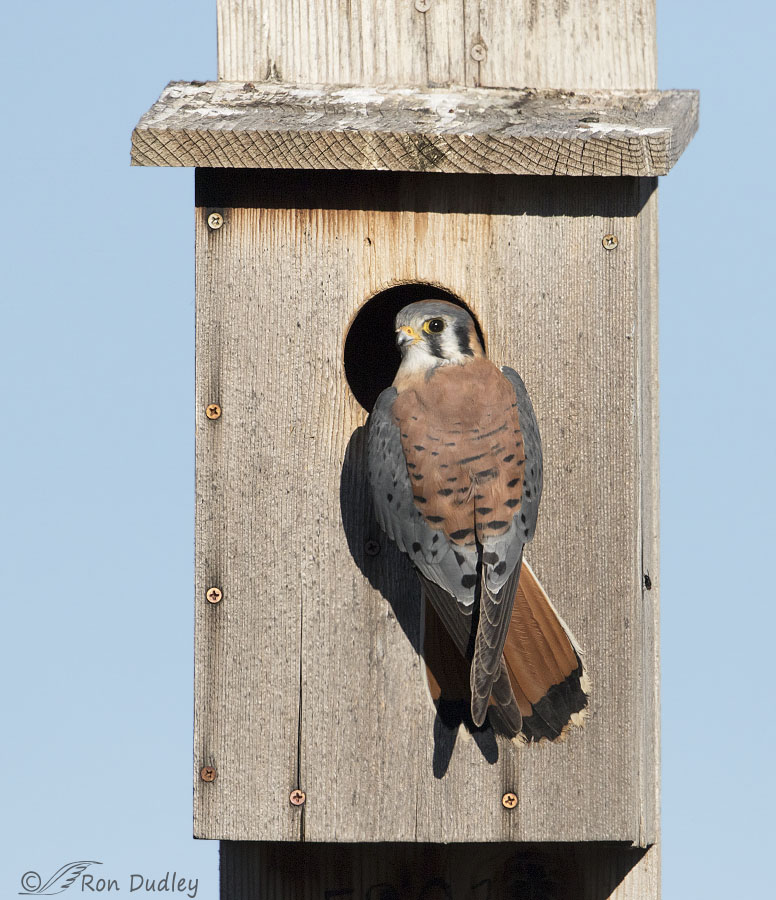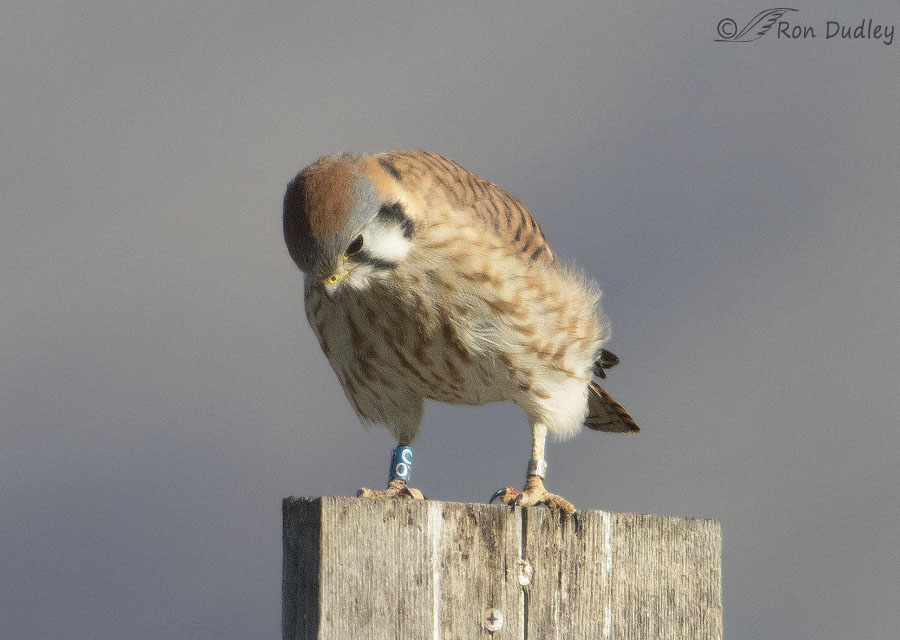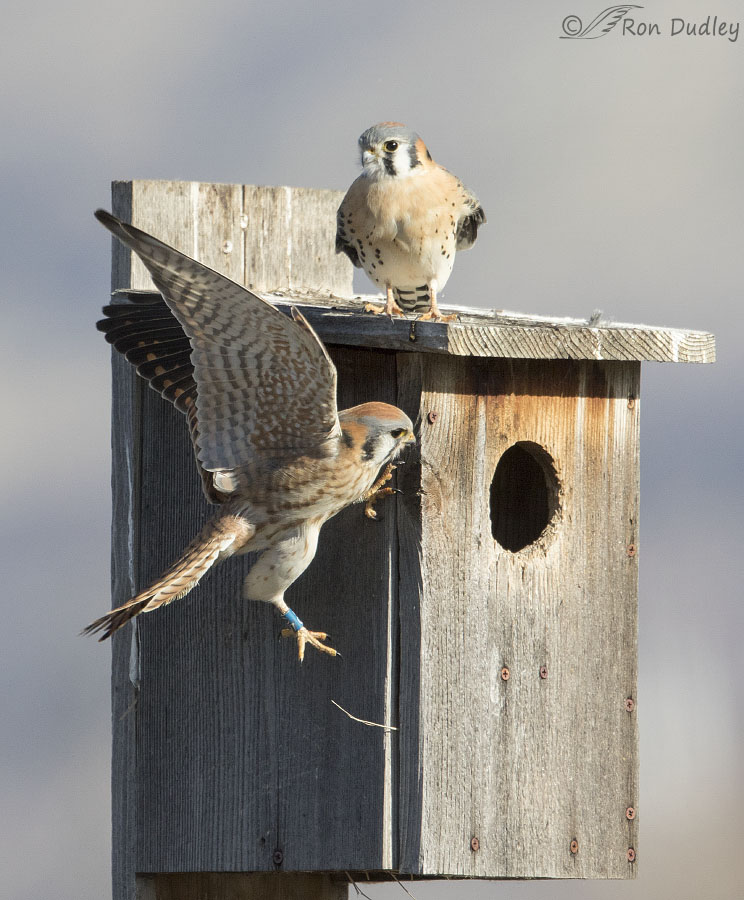American Kestrels are in trouble. Numerous studies indicate that their populations across North America are in a long-term decline and we don’t know why. For that reason several years ago HawkWatch International initiated their American Kestrel Study to better understand the decline so that conservation efforts can be channeled into the most effective strategies to reverse it.
The project is ambitious and involves a small army of dedicated individuals from professional ornithologists to citizen scientist volunteers to birders, bird photographers and nature lovers all of whom are passionate about kestrels and their survival. Some of the highlights to date include:
- 470 kestrel nest boxes monitored along an urban gradient (wild lands, agricultural, urban, and heavily developed areas)
- 307 kestrel nesting attempts followed since 2014
- 1,104 American Kestrels banded, including 478 color-banded individuals
- Over 6000 hours contributed by 155 citizen scientists, to date
But now that much of the preliminary work has been done they need eyes. Lots of eyes.

1/4000, f/7.1, ISO 500, Canon 7D Mark II, Canon EF 500mm f/4L IS II USM + EF 1.4 III Extender, not baited, set up or called in
This is one of HWI’s several kestrel nest boxes at Farmington Bay WMA. Kestrel nest boxes are pretty easy to recognize if you know what you’re looking for.
Two days ago I was contacted by HWI Development and Marketing Director Joseph Dane asking that I help publicize a new system for reporting banded American Kestrels. Traditional USGS metal bird bands are small and very difficult to read except on recaptured or deceased birds but HWI has been using larger, more colorful and unique alphanumeric bands that allow for easier identification from a distance and eliminate the need to recapture the bird (or find it dead) to tell ‘who’ it is. That’s where folks like many of us birders and bird photographers with our powerful binoculars, spotting scopes and lenses come in.
More about that to follow.
1/1600, f/6.3, ISO 500, Canon 7D Mark II, Canon EF 500mm f/4L IS II USM + EF 1.4 III Extender, not baited, set up or called in
This is a recent photo of a pair of mated kestrels at one of HWI’s other nest boxes at Farmington. Notice that the female of the pair (in flight) has a large colored band on her right leg. That band was placed by HWI.

1/4000, f/6.3, ISO 500, Canon 7D Mark II, Canon EF 500mm f/4L IS II USM + EF 1.4 III Extender, not baited, set up or called in
In a different photo of her that I’ve cropped heavily I can easily read the alphanumeric code on that band (she also has a more traditional USGS metal band on her left leg). Because the nest box is close to the road at Farmington this bird has already been reported to HWI several times. But that’s not the case with most banded kestrels so HWI needs our help.
So please, if you see a banded kestrel up close make note of as much of the following information as possible and report it on HWI’s new kestrel sighting form online.
- the sex of the bird (easy to determine in kestrels)
- which leg the band is on
- the alphanumeric code
- date and location
- include a photo if possible
- HWI will report back to you what they know about that particular bird (it’s very rewarding to know some of the details about the birds we report)
These color banded kestrels will most likely be seen in the Intermountain West but kestrels move about and natural dispersal is one of the factors HWI is investigating. Who knows where some of them might show up.
From this project HWI hopes to gain a better understanding of kestrel movements and survival, particularly in different types of human-modified landscapes. While the ideal resighting is of a color-banded bird with a complete alphanumeric code, partial information is still helpful, as are reports of birds with metal (USGS) bands only–a Kestrel with metal only on the right leg is most likely a nestling out of one of HWI’s boxes, and those resights/locations are quite helpful too.
I thank you, HWI thanks you and most importantly American Kestrels thank you.
Ron
Notes:
- Some of us, including me, have mixed feelings about banding. Some of it is unnecessary and the process of banding puts stress on birds. But when it’s a well-designed study attempting to address a critical need banding is often essential and its positives far outweigh any negatives for the birds. In my view HWI’s American Kestrel Study is one of those instances.
- Personally I’ve bookmarked the link to this new HWI band reporting form and I hope others will consider doing something similar.



Saw a pair of Kestrels yesterday near the Experimental Forest at a federal plant material farm. Will have to go back and check for bands on them.
They are quite prevalent where I am. I’ll toss some binoculars in the car and start looking. 😀
Good hunting, Arwen!
Excellent – as a past bander this is great! Kudos to you and HWI.
Unfortunately Kestrels are few in our area.
Thanks, Dick. HWI deserves the credit. I’m just the messenger boy…
What a wonderful initiative. The more people involved the better.
Agreed, EC. Who knows, maybe one of our kestrels will make it all the way down to Australia just to see you!
I saw my first Kestrel a couple months ago of all places, a bird identifying class❗️ He sat and posed for quite a long time. What a treat 😃 I’ll be on the lookout for more here in Sacramento CA.
Beautiful shots of this bird Ron
Thanks, Diana. Kestrels are spectacular little falcons.
I love the American Kestrel too and have seen them in Colorado and Texas–the two places I bird throughout the year. I haven’t noticed the colored banding on them but will be on the look out for that. I placed information about your post on the Birds of Texas FB group and included a link to this specific blog since it was so informative and included the link for submitting sightings. I’ve pasted below the info I posted on Birds of Texas. I realize now that I should have asked permission prior to posting the link to your blog, so if you are unhappy about this, let me know, and I will delete if from Birds of Texas. If it’s okay, I will also post this info on another FB page I’m part of, Colorado Bird Photography. Julie
I get daily posts from an informative birding blog called “Feathered Photography;” this morning Rod Dudley, owner of FP, posted information about a bird I love–the American Kestral, which are in decline. HawkWatchInternational has contacted him about ways to help–one being to “spread the word.” He’s included in this blog post a link to submit an online form for sightings of banded kestrels. If anyone is interested, here’s the link to his blog post:
A New Way To Report Banded American Kestrels
Now that much of the preliminary work for this project has been done…
FEATHEREDPHOTOGRAPHY.COM
Spread the word by posting the link as much as you like, Julie (though you might want to fix the typo on my first name 🙂 )The more folks know about it the better. Thank you.
Saw a banded Eagle !!!!!! Couldn’t read band of course and still no camera .. I don’t know what to do anymore ..
I hope you get your gear back from Canon soon, Marina.
what a wonderful series of shots and info Ron!
Charlotte
Thank you, Charlotte.
Ron – good information and beautiful photos – I participate in this project here in Prescott AZ and am looking forward to possibly being able to see my first banding sometime in early June.
Everett Sanborn
That’s great, Everett. The more participants there are the better it is for kestrels.
We see Kestrels along the Texas Gulf Coast and inland all during the winter. Thanks for the information and perhaps in years to come we will spot a banded bird!
I hope you do, Linda. Thanks.
I saw my first kestral this year, at one of our wildlife refuges. I’ve had multiple sightings of it, and now I’m going to have to make some inquiries. There are wooden boxes scattered around the refuge that I’ve assumed are for bluebirds. Now, I wonder if they might be kestral boxes. I’ll find out, and I’ll look for the kestrals.
Good! Thanks, Shoreacres.
Beautiful birds and GREAT project 🙂 I’m sure you putting it out there will help. I will be watching tho what I’ve seen here is pretty far away…. On another note concerns are being expressed about water fowl migration starting here soon as Freezeout lake near Fairfield, MT is still frozen which will present a problem for Snow Geese, Tundra Swans etc. Haven’t heard how Benton Lake is doing.
Yeah, Freezeout is an important stop for them, Judy. I can’t believe that all those years I lived in Cut Bank I’ve still never been to Freezeout. Sure heard a lot about it since I moved to Utah though…
I haven’t either and I’m a LOT closer…..;) Big Sag near here also gets quite a few Snow Geese – know it’s frozen also.